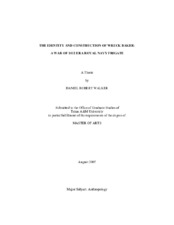| dc.description.abstract | The aim of this research is to determine the identity of a wooden ship located at the bottom of a shallow bay near Kingston, Ontario. The wreck, designated 'Wreck Baker', underwent an archaeological survey, directed by the author, in 2000. Using the archaeological information gathered in conjunction with historical research at the National Archives of Canada and in secondary sources, Wreck Baker will be identified as Princess Charlotte. On Christmas Day 1814 the frigate HMS Psyche splashed into the ice cold waters of Lake Ontario to take part in a war that had ended one day earlier with the signing of the Treaty of Ghent. The Psyche's launch was the fourth of the year, following the frigates HMS Princess Charlotte, and HMS Prince Regent, and the First Rate HMS St. Lawrence. Three of these four ships now rest at the bottom of Lake Ontario. Two of the wrecks have been identified as St. Lawrence and Prince Regent, the largest ships built by the Royal Navy at Kingston. The size and construction of the third wreck provide important clues to its identity. This wreck, called both Wreck Baker and Deadman Bay II by previous investigators, is located, along with Prince Regent (Wreck Able, Deadman Bay I) on the bottom of Deadman Bay at the north-east corner of Lake Ontario, near Kingston, Ontario.In the summer of 2000 an archaeological survey was undertaken with the aim of recording and understanding the unique construction of Wreck Baker to conclusively determine whether it was Princess Charlotte or Psyche. Understanding the construction of Wreck Baker required dives into Lake Ontario and the National Archives of Canada. The work in Lake Ontario provided insight into how the ship was built and the archival work provided the historical context that explains the ship's novel construction. Wreck Baker's archaeologically recorded shape, length, and construction were compared with the ships in the historical record leading to the identification of Wreck Baker as Princess Charlotte. | en |


